Why this matters
Jobs aren’t only won with perfect Big-O explanations. They’re often won because someone helpful remembered you when a role opened. Networking is how you create those moments on purpose, without feeling like a walking sales pitch.
Think of it as engineering for luck: you design tiny, low-friction interactions that compound over time. No schmoozing required. Just clear asks, useful follow-ups, and a human tone.
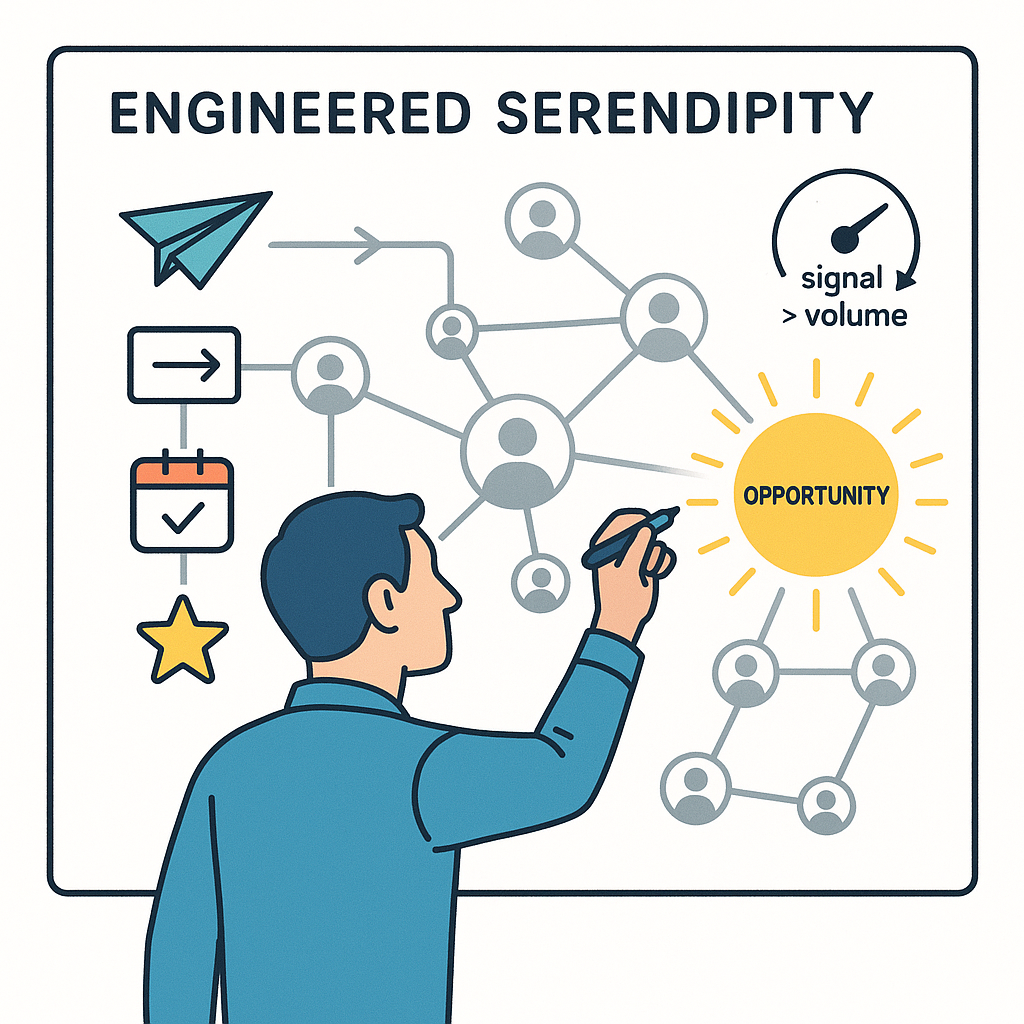
Networking mental model
Networking = signal over volume. You don’t need to message 200 people; you need to reach the right 5 with the right context at the right moment.
Treat it like a system:
- Inputs: people, channels, messages.
- Process: match relevance, make a specific ask, follow up politely.
- Outputs: conversations, referrals, serendipity.
Optimize for repeatability: small templates, a simple tracker, and a weekly cadence you can keep even during crunch weeks.
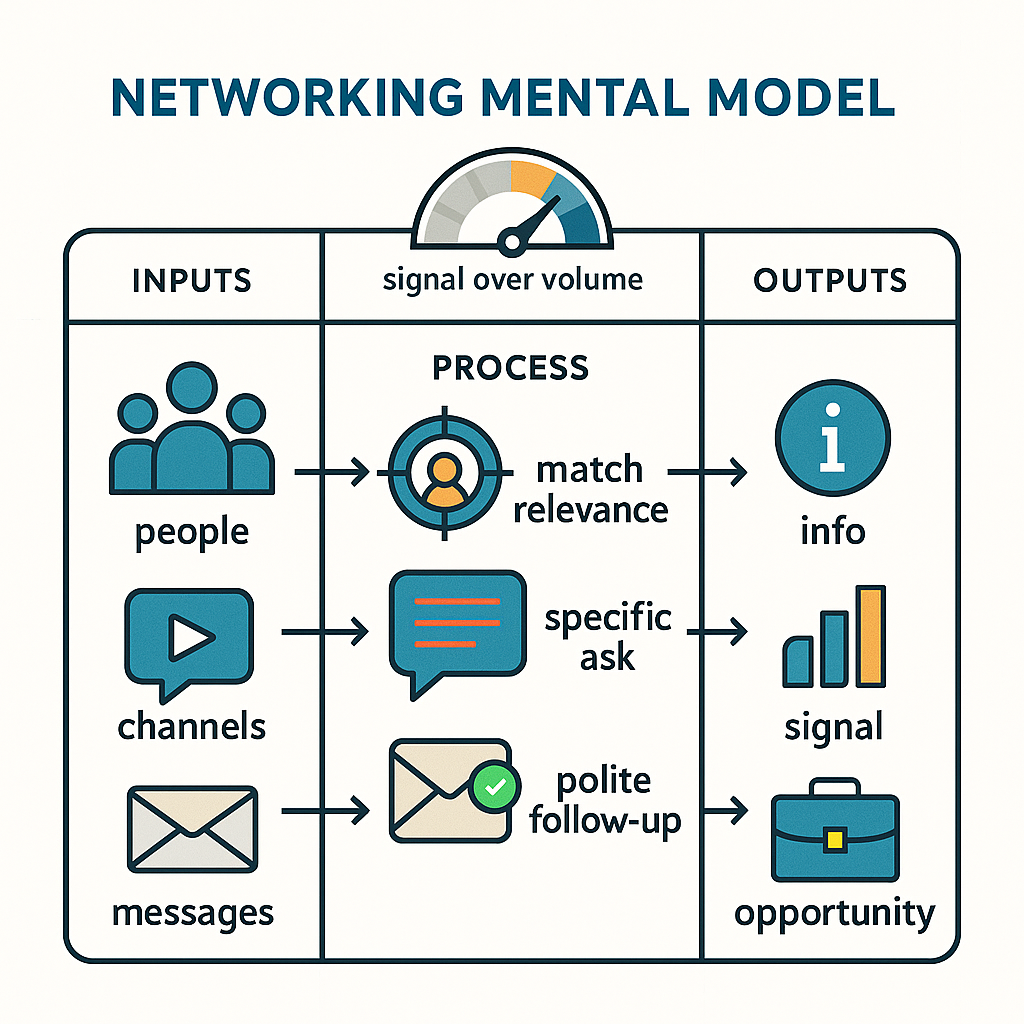
Are you sure you're getting this? Click the correct answer from the options.
Which approach best reflects the lesson’s 'signal over volume' principle?
Click the option that best answers the question.
- Send tailored messages to 5 relevant people with specific context and a tiny ask.
- Message 200 people with a generic 'open to connect' note.
- Post your resume link weekly on every platform.
- Wait for recruiters to find you organically.
Try this exercise. Is this statement true or false?
A strong first message should be brief (about five sentences) and include a tiny, time‑boxed ask.
Press true if you believe the statement is correct, or false otherwise.
Anti-cringe rules
- Be useful: offer something (insight, feedback, small help) before you need something big.
- Be specific: “15 minutes for two questions about your team’s on-call?” beats “Can I pick your brain?”
- Be brief: 5 sentences max. Respect attention like you respect CPU cycles.
- Be normal: write like you talk at standup. No faux grandeur, no “Esteemed Sir/Madam.”
“The less you try to impress, the more human you sound.”
Try this exercise. Could you figure out the right sequence for this list?
Order the outreach sequence from first to last.
Press the below buttons in the order in which they should occur. Click on them again to un-select.
Options:
- Warm contacts (former teammates, classmates)
- Warm‑ish contacts (alumni you haven’t met, maintainers you interacted with)
- Cold contacts (shared company/role interest, no prior touch)
Map your network
Start with warm then expand to warm-ish then cold.
- Warm: former teammates, classmates, managers, mentors, hackathon buddies.
- Warm-ish: alumni you’ve never met, maintainers whose repos you’ve contributed to, people who liked your post.
- Cold: shared company/role interest with no prior touch.
Make a quick inventory:
People: names you can actually message.Shared context: school, repo, talk, community.Angle: how you’re relevant to them (not just to you).

Define your ask
A good ask is tiny, schedulable, and easy to say yes to.
- Goal types:
info(learn),signal(be known),opportunity(get referral). - Examples:
- “Could you sanity-check my 2-sentence pitch for the Platform Eng role at X?”
- “Are you the right person to ask about infra intern openings?”
- “Open to a referral if my background fits? Happy to send a forwardable blurb.”
Make it binary-answerable and time-bound (5–15 minutes). Always offer an easy opt‑out.
Pick the channel
Different channels, different norms:
Email: best for detail + forwarding. Great for referrals and “forwardable blurbs.”LinkedIn: short notes; good for connection + quick context. Expect slower replies.X/Slack/Discord: great for fast, casual pings after a public interaction.GitHub: perfect when your context is code (issues, PRs).IRL(meetups, conferences): start warm, follow up online within 24–48 hours.
Rule of thumb: match the channel to the context where you “met” them.
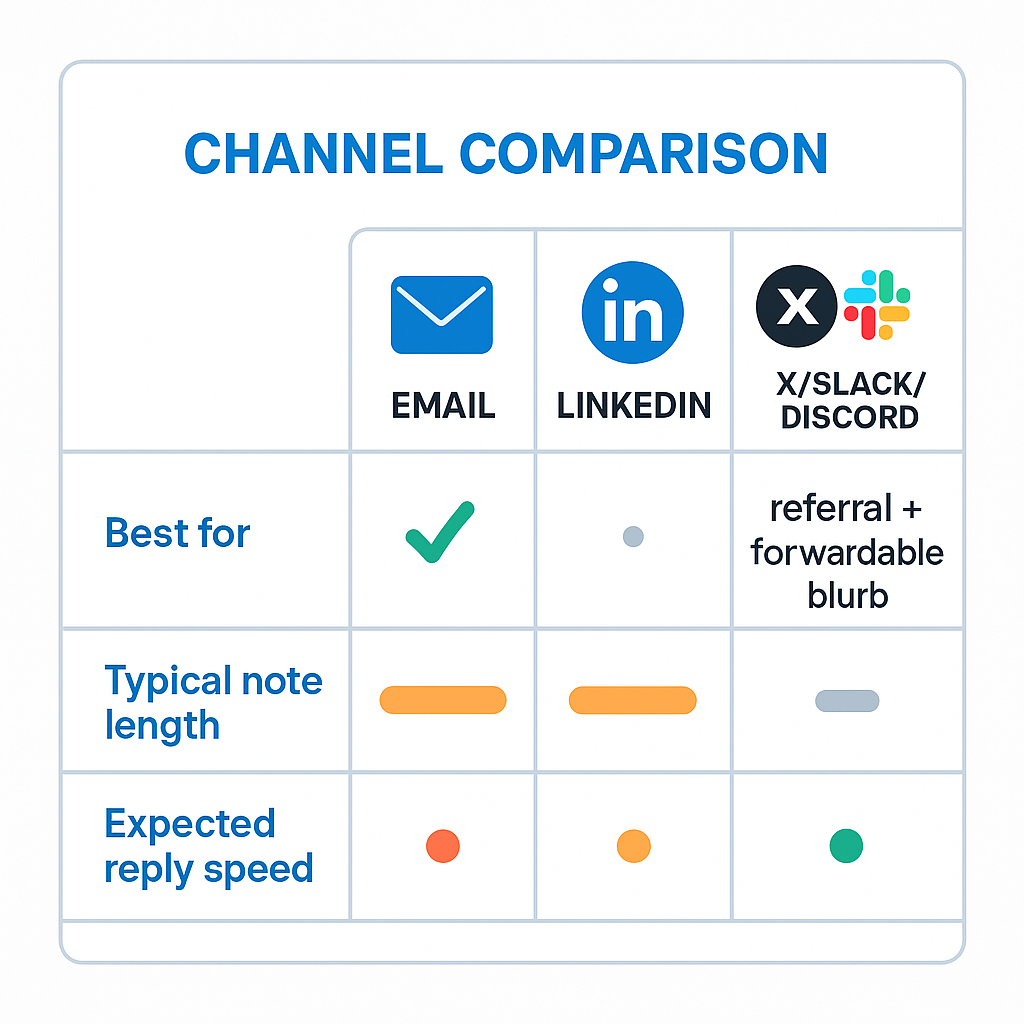
Let's test your knowledge. Click the correct answer from the options.
You want to ask for a referral and include a forwardable blurb. Which channel is usually best?
Click the option that best answers the question.
- LinkedIn note
- Twitter/X DM
- GitHub issue comment
Message anatomy
Five parts, five sentences:
- You + context: who you are, why you’re relevant.
- Why them: a specific hook (their post, repo, talk, role).
- Credibility in one beat: a concrete, verifiable detail.
- The ask: tiny, binary, time-boxed.
- Exit ramp: “No worries if not.”
Keep it skimmable. Aim for ~100–150 words.
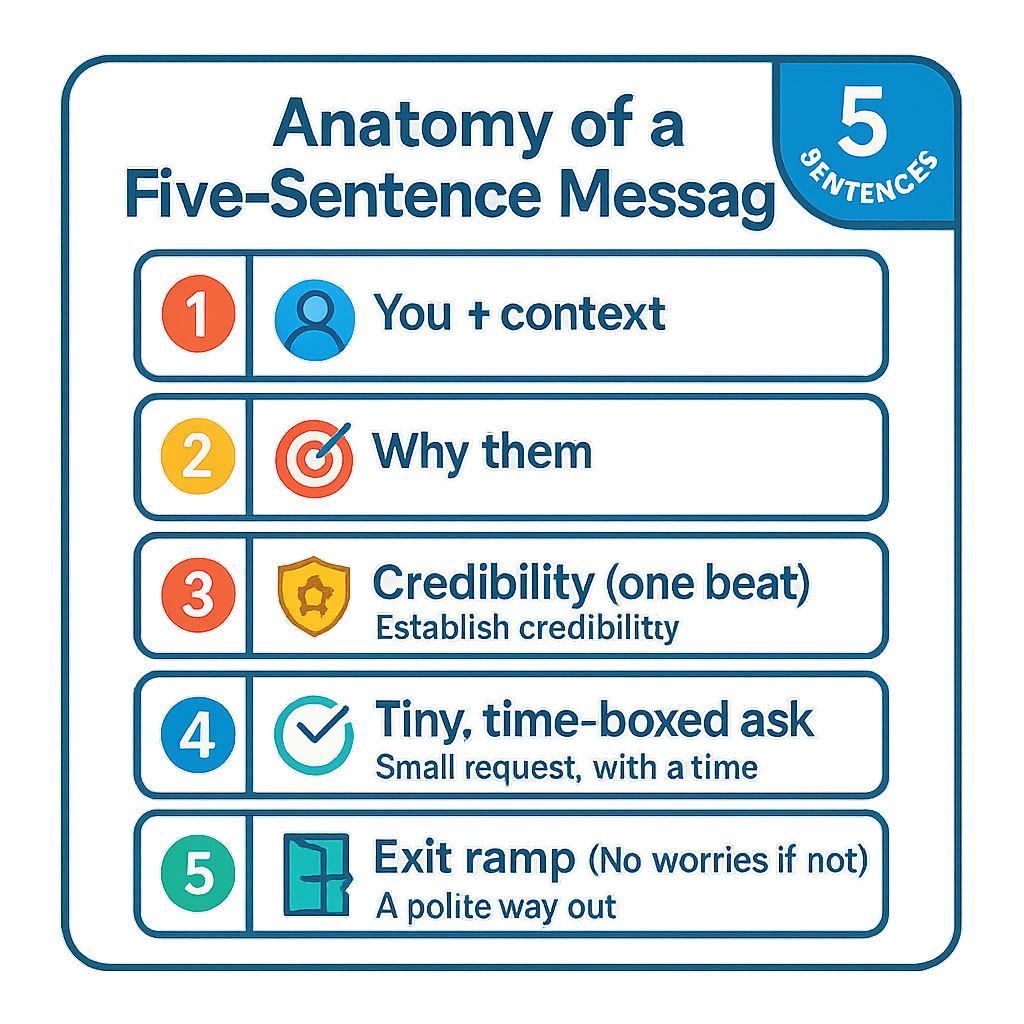
Let's test your knowledge. Could you figure out the right sequence for this list?
Put the parts of a strong outreach message in order.
Press the below buttons in the order in which they should occur. Click on them again to un-select.
Options:
- You + context (who you are and why you’re relevant)
- Why them (specific hook: their post/repo/talk/role)
- Credibility in one beat (verifiable detail)
- The tiny, time‑boxed ask
- Exit ramp (No worries if not)
Proven templates
Alumni (email or LinkedIn):
Hi Maya — fellow UW alum (’22, CSE). Loved your blog on feature flags at FinFast; I’m working on a similar toggle system in a side project. Would you have 10 minutes this week for two questions about how your team rolls out infra changes safely? Totally fine if timing’s bad — appreciate any pointers. Thanks!
Open-source angle (GitHub → email):
Hey Alex — thanks for reviewing my PR #482 on
foo-cache. I’m applying for a caching role at BarTech (your old team). Mind if I send you a 3‑sentence background for feedback or a referral if it aligns? All good if not — grateful for your time either way.
Event follow-up:
Hi Priya — enjoyed your QCon talk on incident runbooks. I volunteer on our on‑call rotation and tried your “first page is only links” idea. Could I ask two quick questions about metrics you track pre‑mortem? Happy to email instead if easier.
Mutual intro request (to a friend):
Hey Sam — would you be comfortable intro’ing me to Jordan on the ML Platform team? Draft blurb below to copy/paste if so. Zero pressure if it’s not a fit.
Company-interest cold email:
Subject: Tiny ask re: Platform Eng @ Northwind Hi Jordan — I’m a backend engineer who shipped the RBAC migration at Contoso (cut P95 auth latency 28%). I’m exploring Platform roles and Northwind’s roadmap caught my eye (particularly the service mesh work). Would you be open to a 10‑minute chat, or pointing me to the right person? No worries if not — thanks for reading.
Subject lines & notes
Subject lines that get opened:
- “Quick question about <team/tech>”
- “Fellow <alumni/community> + tiny ask”
- “Thanks for <talk/post> + one follow‑up”
- “Intro request (easy copy/paste inside)”
LinkedIn connection notes (<=300 chars):
- “Fellow UCLA CS; loved your post on migrations. Could I ask two quick Qs about your rollout checklist?”
- “Contributed tests to your
s3-syncrepo; would love to connect and learn how your team triages PRs.”
Warm intro flow
When asking for an intro, do the work for the referrer.
- Ask permission first: “Are you comfortable introducing me to Alex?”
- Provide a
forwardable blurb:- Who you are (1 sentence).
- Why this person (1 sentence).
- The tiny ask (1 sentence).
- Links: LinkedIn/GitHub/resume.
Example blurb:
“Hi Alex — CC: Jordan. Jordan and I overlapped on Contoso’s platform team; he led the RBAC migration (link). He’s exploring similar roles and had two questions about your service mesh rollout; 10 minutes if possible. If now’s not a good time, no worries.”
Build your intuition. Click the correct answer from the options.
You’re asking a mutual to introduce you to Alex. What’s the correct first move?
Click the option that best answers the question.
- Send a calendar invite to Alex and CC the mutual.
- Ask the mutual if they’re comfortable making the intro and include a forwardable blurb.
- DM Alex directly and say the mutual will intro you soon.
- Attach your full resume, portfolio, and slide deck to the mutual.
Informational chats
You asked for time — now make it count.
- Agenda (15–20 min):
- 2 min: thanks + context.
- 10–12 min: questions (prioritize).
- 3–5 min: next steps + help you can offer.
- Question bank:
- “If you were me, what one project would best signal fit for your team?”
- “What surprised you about this role after joining?”
- “Which skills would get someone promoted here?”
- Close strong: ask “Anyone else I should talk to?” and “May I keep you posted?”
Send a same-day thank-you with one sentence on what you’ll do next.
Let's test your knowledge. Could you figure out the right sequence for this list?
Arrange these follow‑up steps in the recommended order.
Press the below buttons in the order in which they should occur. Click on them again to un-select.
Options:
- Nudge #1 after 3–5 business days with a short bump; include the original below
- Nudge #2 after 7–10 more days; give permission to pass and restate the ask briefly
- Close the loop with an outcome note if they help
Follow-up cadence
Silence isn’t a verdict; it’s a busy calendar.
- Nudge #1 (after 3–5 business days): short bump, include original below.
- Nudge #2 (after 7–10 more days): “Totally fine to pass — leaving this with you. If helpful later, here’s a 2‑line summary of what I’m asking.”
- Close the loop: if you get help, send an outcome note (“Got the interview — thanks again!”). It’s memorable.
Bump template:
Hi Taylor — friendly nudge on my note below. If now’s not ideal, I’ll circle back next month. Thanks either way!

Give before you get
Ways to be useful in <15 minutes:
- Triage a bug report with steps to reproduce.
- Write a tiny doc improvement or test.
- Share curated links or your notes from a talk.
- Send a candidate lead to a hiring manager.
- Introduce two people who asked for the same thing (with consent).
Value compounds. Be the person who closes loops and ships small helpful things.
Events playbook
Before:
- Pick 3 people to meet; prep one question each.
- Post a short intent: “Going to SF Python tonight; curious about data quality tools.”
During:
- Start with context + question. Avoid “What do you do?”; try “What problem brought you here?”
- End with a tiny action: “Mind if I DM my notes?”
After (within 24–48 hours):
“Great to meet you at DevOpsDays — you mentioned migrating off Jenkins. Here are my notes + a link to a GitHub action we used. Open to a 10‑minute follow‑up?”
Let's test your knowledge. Fill in the missing part by typing it in.
In the 3‑2‑1 cadence, how many new touches, follow‑ups, and give‑first actions do you aim for each week? Answer as numbers or phrase (e.g., 3‑2‑1 or '3 new touches, 2 follow‑ups, 1 give‑first').
Write the missing line below.
Track the system
You don’t need a CRM. A sheet works.
Columns to keep:
Name,Handle/Email,Company/RoleContext(alumni, repo, event)Last touch(date)Status(sent, replied, scheduled, closed)Next step(nudge date, action)Notes(what they care about)
Weekly habit: 3 new touches, 2 follow-ups, 1 give-first action. That’s the 3‑2‑1 cadence.
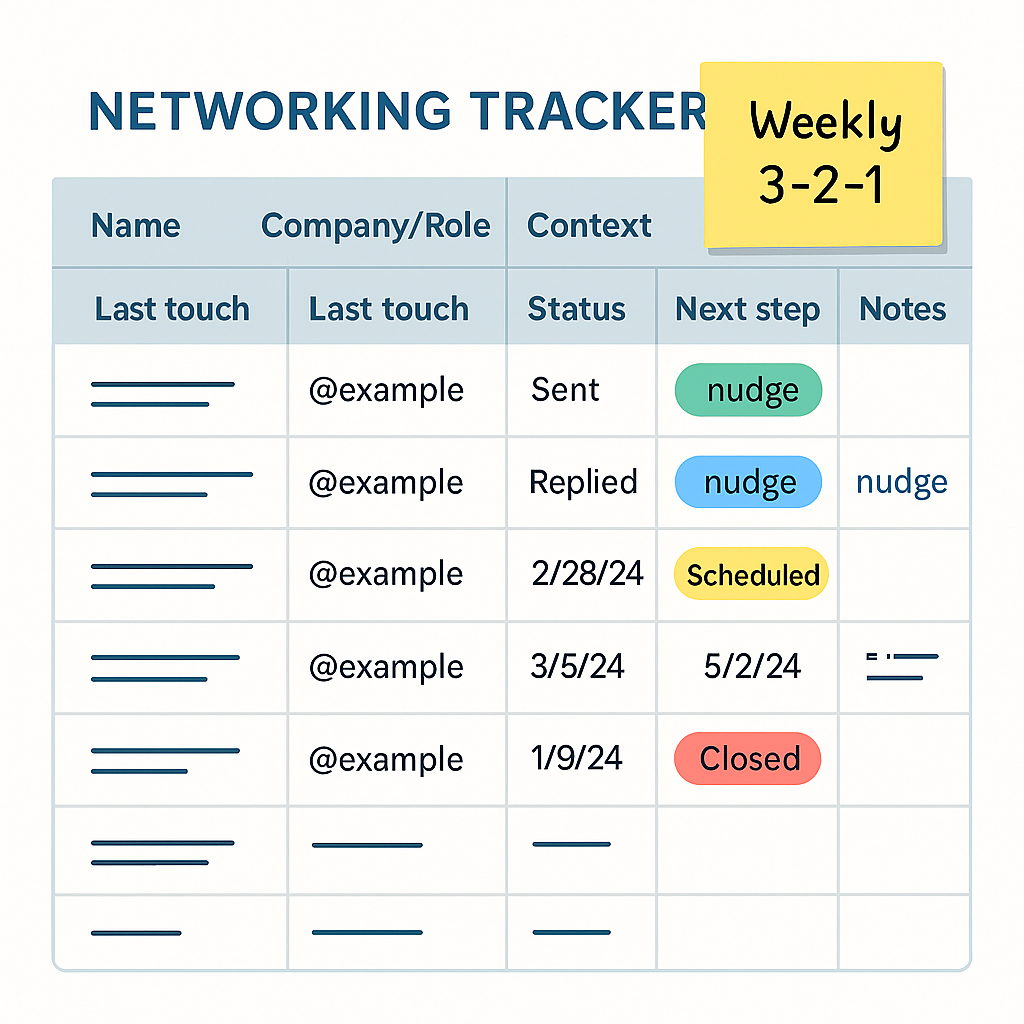
Boundaries & etiquette
- Time zones: propose windows in their zone; include yours.
- Calendars: offer slots first; share a scheduling link only if they ask or if coordination drags.
- Consent: don’t add people to group threads without asking.
- Resumes: send on request, or attach only when explicitly relevant (referral flow).
- Recording: always ask before recording a chat. Default is off.
- Accessibility: include a phone alternative; keep acronyms minimal.
Polite defaults travel well across companies and cultures.
Advanced moves
- Public artifacts: small posts on how you solved X with Y. Real details beat generic “passion for tech” lines.
- “Working in public”: issue comments, design docs, small OSS PRs. These create
asynchronous reputation. - Momentum notes: monthly update to a small BCC list of supporters (wins, asks, gives). Keep it short; always include a give.
Optional, powerful, compounding.
Anti-patterns
- Vague asks: “Would love to connect” with no reason.
- Bait-and-switch: “Just advice” → “Actually, can you refer me?” in the same call.
- Attachment overload: 7MB resume + portfolio + slide deck on first contact.
- Spray-and-pray: same generic message to 50 people (someone will screenshot it).
- Calendar link first message: feels transactional; earn it.
- Negging yourself: “Sorry to bother you” x3. Be respectful, not apologetic.
Mini scripts you can steal
First DM (mutual context):
“Hi Ana — fellow Recurse alum. Your thread on zero-downtime migrations helped me ship one last week. Could I ask two quick Qs about how you backfilled safely? Happy to move to email.”
Referral ask (after a good chat):
“Thanks again, Dan. If you think I’m a fit for the Platform Eng opening, would you be open to referring me? Here’s a 3‑line summary and job link — totally fine if not.”
Thank-you + loop close:
“Appreciate your time today, Priya. I’m trying your ‘runbook first page’ idea next sprint; will report back. If helpful, I can share a template once we iterate.”
Recap
- Networking is engineered serendipity: small, specific, respectful touches that compound.
- Use
signal > volume: clear context, tiny asks, human tone. - Tools: five-sentence message, forwardable blurb, 3‑5‑9 follow-ups, 3‑2‑1 weekly cadence.
- Behaviors: give first, close loops, track lightly, respect boundaries.
Do this for eight weeks, not one day. You won’t feel cringe. You’ll feel effective — and you’ll be on more shortlists.



